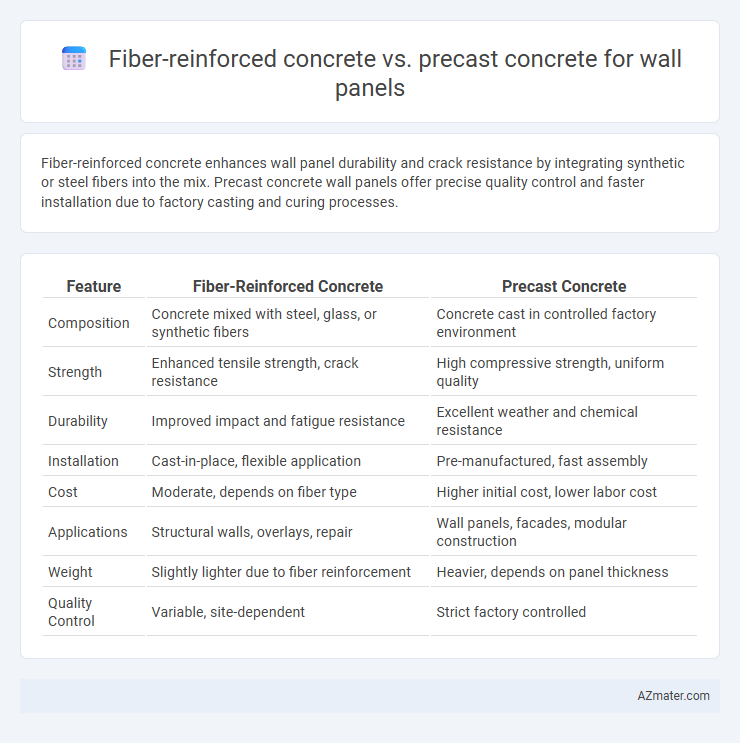Fiber-reinforced concrete enhances wall panel durability and crack resistance by integrating synthetic or steel fibers into the mix. Precast concrete wall panels offer precise quality control and faster installation due to factory casting and curing processes.
Table of Comparison
| Feature | Fiber-Reinforced Concrete | Precast Concrete |
|---|---|---|
| Composition | Concrete mixed with steel, glass, or synthetic fibers | Concrete cast in controlled factory environment |
| Strength | Enhanced tensile strength, crack resistance | High compressive strength, uniform quality |
| Durability | Improved impact and fatigue resistance | Excellent weather and chemical resistance |
| Installation | Cast-in-place, flexible application | Pre-manufactured, fast assembly |
| Cost | Moderate, depends on fiber type | Higher initial cost, lower labor cost |
| Applications | Structural walls, overlays, repair | Wall panels, facades, modular construction |
| Weight | Slightly lighter due to fiber reinforcement | Heavier, depends on panel thickness |
| Quality Control | Variable, site-dependent | Strict factory controlled |
Introduction to Wall Panel Construction Methods
Fiber-reinforced concrete offers enhanced tensile strength and crack resistance, making it suitable for wall panels requiring durability and impact resistance. Precast concrete wall panels are manufactured off-site under controlled conditions, ensuring high quality, uniformity, and faster on-site installation. Both methods provide distinct advantages in wall panel construction, with fiber reinforcement enhancing performance and precasting optimizing production efficiency.
Overview of Fiber-Reinforced Concrete
Fiber-reinforced concrete (FRC) integrates discrete fibers such as steel, glass, or synthetic materials into the concrete mix to enhance tensile strength, durability, and crack resistance, making it ideal for wall panels exposed to high stress or impact. Unlike traditional precast concrete, FRC offers improved toughness and reduced permeability, which extends the lifespan of structural panels in harsh environmental conditions. This innovative material reduces reliance on steel reinforcement, streamlines installation, and improves overall structural integrity in wall panel applications.
Overview of Precast Concrete Systems
Precast concrete systems consist of factory-made wall panels that offer high quality control, uniformity, and faster on-site installation compared to fiber-reinforced concrete. These panels are produced in controlled environments, enhancing durability, reducing construction time, and minimizing labor costs. Precast concrete's versatility allows integration of insulation, finishes, and embedded utilities within the wall panels, improving thermal performance and construction efficiency.
Material Properties Comparison
Fiber-reinforced concrete (FRC) exhibits enhanced tensile strength and crack resistance due to the incorporation of synthetic or steel fibers, making it ideal for wall panels requiring durability and impact resistance. Precast concrete panels benefit from controlled factory curing, resulting in consistent compressive strength and superior dimensional accuracy, which reduces onsite errors. While FRC offers improved flexural toughness and reduced permeability, precast concrete provides better quality control and faster installation times for wall panel applications.
Installation and Construction Processes
Fiber-reinforced concrete wall panels simplify installation by reducing the need for additional reinforcement and minimizing labor due to their enhanced tensile strength and crack resistance. Precast concrete panels offer a faster construction process through off-site manufacturing, allowing precise quality control and rapid on-site assembly, but require heavy equipment and careful handling during transportation and installation. Both materials improve durability, but fiber-reinforced panels typically enable more flexible on-site adjustments compared to the rigid, factory-made precast counterparts.
Cost Analysis and Budget Considerations
Fiber-reinforced concrete wall panels generally offer lower labor costs due to faster installation and reduced need for heavy reinforcement, resulting in shorter project timelines. Precast concrete panels involve higher upfront manufacturing and transportation expenses but provide consistent quality and potential savings through reduced on-site labor and waste. Budget considerations should weigh initial material and production costs of precast against the long-term savings from fiber-reinforced concrete's durability and lower maintenance requirements.
Durability and Maintenance Requirements
Fiber-reinforced concrete wall panels exhibit enhanced durability due to improved crack resistance and impact strength, resulting in fewer repairs over time compared to standard precast concrete panels. Precast concrete panels offer consistent quality and dimensional accuracy but may require more frequent inspections and maintenance to address potential joint sealing and surface wear issues. Maintenance requirements for fiber-reinforced concrete are generally lower, as the distributed fibers help mitigate micro-cracking and reduce long-term degradation under environmental stress.
Structural Performance and Load-Bearing Capacity
Fiber-reinforced concrete exhibits enhanced tensile strength and crack resistance, improving overall structural performance for wall panels by distributing loads more evenly and resisting dynamic stresses. Precast concrete, manufactured under controlled conditions, offers superior uniformity and higher compressive strength, making it ideal for high load-bearing applications with consistent quality. Both materials provide reliable structural solutions, but fiber-reinforced concrete excels in toughness and durability, whereas precast concrete ensures precision and rapid installation.
Sustainability and Environmental Impact
Fiber-reinforced concrete (FRC) for wall panels reduces material usage and enhances durability, lowering the environmental footprint by minimizing resource extraction and waste. Precast concrete panels offer controlled manufacturing conditions that improve quality and reduce waste, but involve significant energy consumption during production and transport. Considering lifecycle assessments, FRC wall panels generally provide better sustainability through increased toughness and longevity, decreasing the need for repairs and replacements over time.
Best Applications and Recommendations
Fiber-reinforced concrete offers superior crack resistance and impact durability, making it ideal for wall panels subjected to dynamic loads or seismic activity. Precast concrete panels provide high dimensional accuracy and rapid installation, best suited for projects requiring expedited construction timelines and consistent quality control. For resilient exterior cladding in demanding environments, fiber-reinforced panels are recommended, while precast panels excel in repetitive modular applications such as commercial or residential building facades.

Infographic: Fiber-reinforced concrete vs Precast concrete for Wall panel
 azmater.com
azmater.com